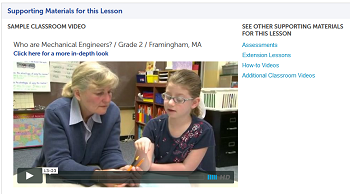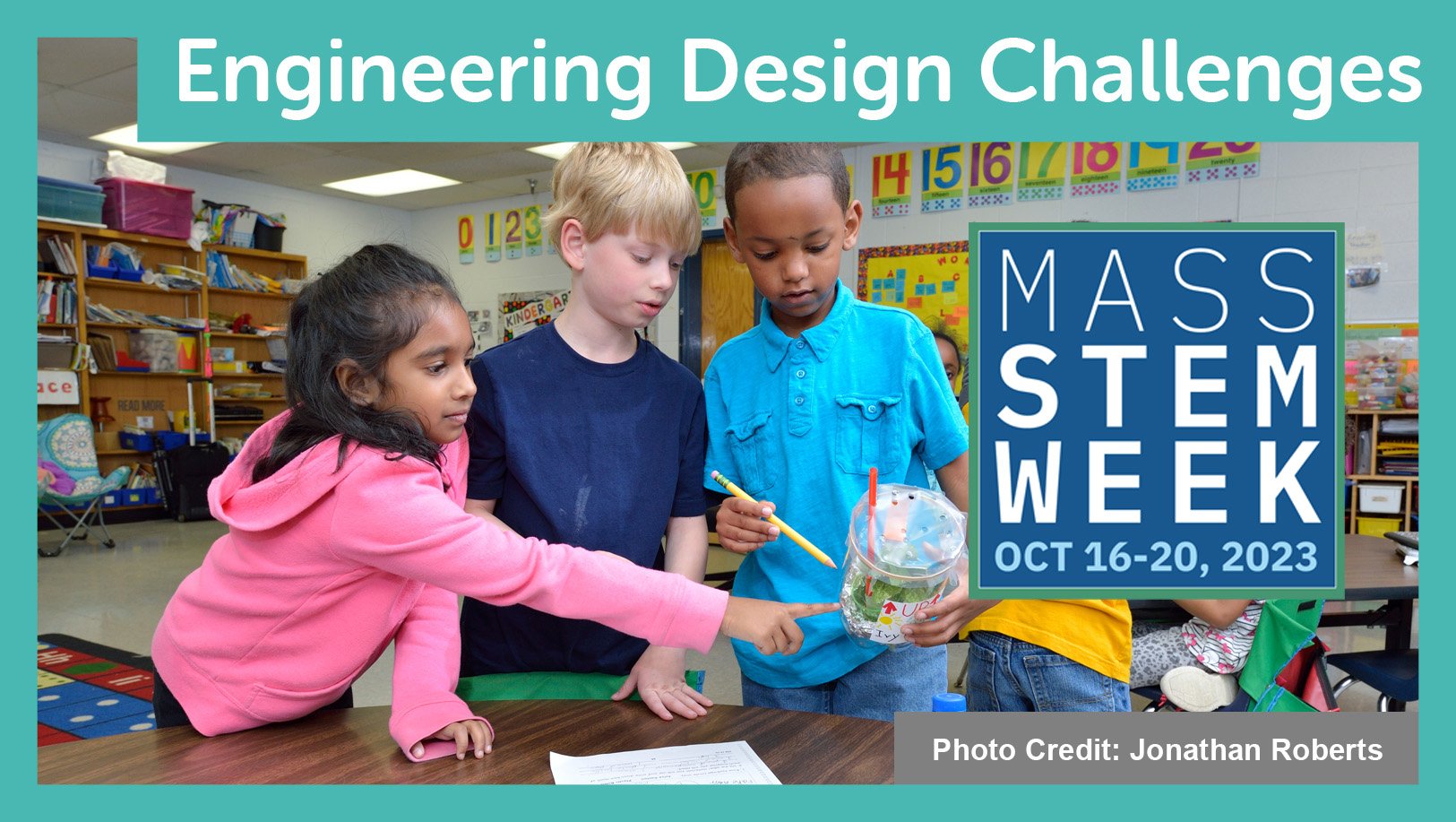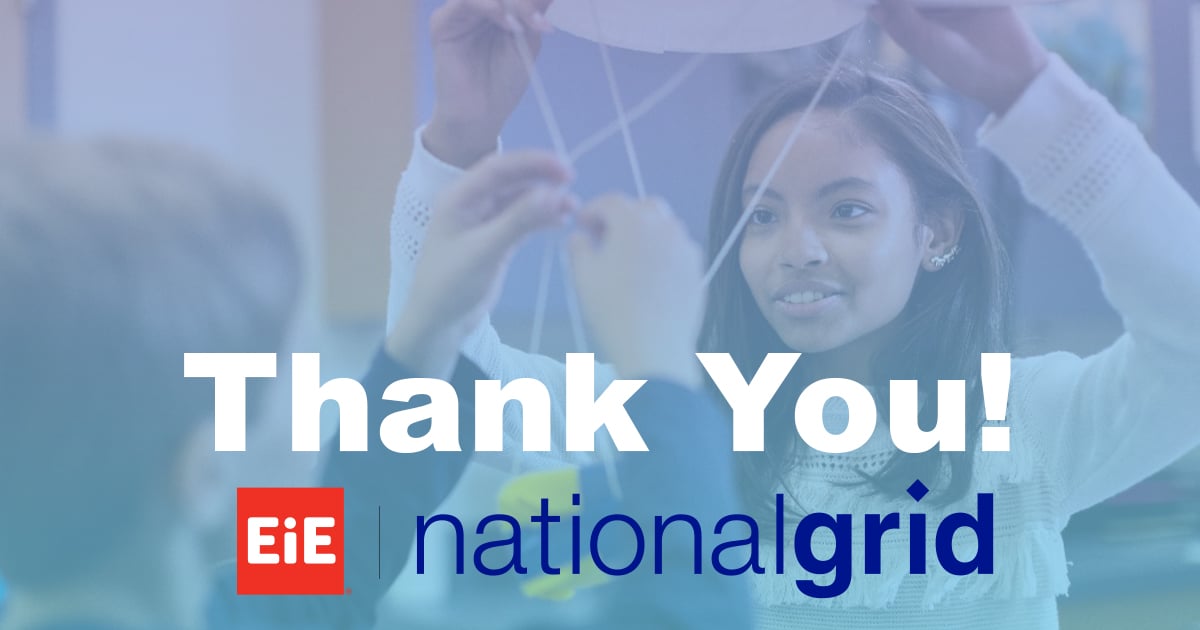
When elementary teachers attend our professional development workshops, we wrap up by asking, “What OTHER resources would be helpful to you?” Teachers often tell us they want a tool that shows exactly what hands-on engineering will look like in their classrooms, and also how lesson materials should be prepared. They ask for videos.
Videos ARE great educational tools. Studies show people learn more effectively from watching a real-life example than they do from simply reading text.
Check each EiE "Unit Page" for links to short videos and other useful resources for teachers.When teachers ask, we listen. EiE’s videography team has put together a library of short videos, nearly 200 and still growing (this month, we added eight new videos to the collection!).
We’ve also made these videos easier to find and use on our new website. When you scroll through each EiE “unit overview” page, you’ll see direct links to the videos that support each lesson. Take a look at our “Windmills” unit (shown at right) and give it a try!

EiE has two kinds of helpful videos:
Classroom Videos show the ins and outs of teaching the four lessons that make up each EiE unit. They take you into real classrooms, to see how students are grouped, how supplies are organized, and the facilitation strategies teachers use to implement the activities. You can also see typical challenges that come up and how experienced teachers address these challenges.
How To Videos help you with lesson prep. These segments show you exactly where to cut the holes in those shoeboxes that will become solar ovens, or how to create a model of the ocean floor. Just prop your tablet or laptop next to your box of classroom materials, press “play,” and follow along.
EiE is an institution that runs on research, so we wanted to know if all these videos were doing the job. For the past 18 months, we’ve been surveying teachers who attend our professional development workshops. To date about one in four respondents say they’re using the video library—and they’re pretty enthusiastic about the experience.
“Keep making the [Classroom] videos--teachers really like seeing the different parts of the lessons,” one teacher said. “And the How To videos are really good, especially for teachers who are intimidated by the [all the materials in the] kits.”
Another teacher noted that she’d never even heard of mag-lev (magnetic levitation) trains before she started teaching the EiE unit on transportation engineering. “Seeing a teacher in action introduce the concepts--and seeing what the finished products looked like--was immensely helpful,” she said.
Beyond EiE there are some other great video collections assembled just for teachers. The Teaching Channel, launched in 2011, says a key part of its mission is to “revolutionize how teachers learn.” Teaching Channel’s elementary science videos cover a wide range of science content, make links to Common Core standards, and demonstrate teaching strategies.
Then there’s PBS Learning Media™, the media-on-demand service formerly known as “Teachers’ Domain.” In addition to the large collection of short videos and interactives selected to enhance teaching of various subjects (including science and math), PBSLM also offers professional development-style videos that show teachers demonstrating classroom-tested techniques.
EiE’s video library is FREE and can be streamed online. Take a look and let us know what you think!
Engineering is Elementary is a project of the National Center for Technological Literacy at the http://www.mos.org/.
When elementary teachers attend our professional development workshops, we wrap up by asking, “What OTHER resources would be helpful to you?” Teachers often tell us they want a tool that shows exactly what hands-on engineering will look like in their classrooms, and also how lesson materials should be prepared. They ask for videos.
Videos ARE great educational tools. Studies show people learn more effectively from watching a real-life example than they do from simply reading text.
 When teachers ask, we listen. EiE’s videography team has put together a library of short videos, nearly 200 and still growing (this month, we added eight new videos to the collection!).
When teachers ask, we listen. EiE’s videography team has put together a library of short videos, nearly 200 and still growing (this month, we added eight new videos to the collection!).
We’ve also made these videos easier to find and use on our new website. When you scroll through each EiE “unit overview” page, you’ll see direct links to the videos that support each lesson. Take a look at our “Windmills” unit (shown at right) and give it a try!
EiE has two kinds of helpful videos:
Classroom Videos show the ins and outs of teaching the four lessons that make up each EiE unit. They take you into real classrooms, to see how students are grouped, how supplies are organized, and the facilitation strategies teachers use to implement the activities. You can also see typical challenges that come up and how experienced teachers address these challenges.
How To videos help you with lesson prep. These segments show you exactly where to cut the holes in those shoeboxes that will become solar ovens, or how to create a model of the ocean floor. Just prop your tablet or laptop next to your box of classroom materials, press “play,” and follow along.
EiE is an institution that runs on research, so we wanted to know if all these videos were doing the job. For the past 18 months, we’ve been surveying teachers who attend our professional development workshops. To date about one in four respondents say they’re using the video library—and they’re pretty enthusiastic about the experience.
“Keep making the [Classroom] videos--teachers really like seeing the different parts of the lessons,” one teacher said. “And the How To videos are really good, especially for teachers who are intimidated by the [all the materials in the] kits.”
Another teacher noted that she’d never even heard of mag-lev (magnetic levitation) trains before she started teaching the EiE unit on transportation engineering. “Seeing a teacher in action introduce the concepts--and seeing what the finished products looked like--was immensely helpful,” she said.
Beyond EiE there are some other great video collections assembled just for teachers. The Teaching Channel, launched in 2011, says a key part of its mission is to “revolutionize how teachers learn.” Teaching Channel’s elementary science videos cover a wide range of science content, make links to Common Core standards, and demonstrate teaching strategies.
Then there’s PBS Learning Media™, the media-on-demand service formerly known as “Teachers’ Domain.” In addition to the large collection of short videos and interactives selected to enhance teaching of various subjects (including science and math), PBSLM also offers professional development-style videos that show teachers demonstrating classroom-tested techniques.
EiE’s video library is FREE and can be streamed online. Take a look and let us know what you think!
Engineering is Elementary is a project of the National Center for Technological Literacy® at the Museum of Science, Boston.
- See more at: http://eie.org/blog/eie-blog-%E2%80%9Cwhat-does-lesson-look-classroom%E2%80%9D#sthash.2lkEXcuh.dpuf







